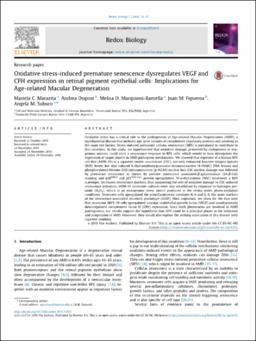| dc.description.abstract | Oxidative stress has a critical role in the pathogenesis of Age-related Macular Degeneration (AMD), a
multifactorial disease that includes age, gene variants of complement regulatory proteins and smoking as
the main risk factors. Stress-induced premature cellular senescence (SIPS) is postulated to contribute to
this condition. In this study, we hypothesized that oxidative damage, promoted by endogenous or exogenous sources, could elicit a senescence response in RPE cells, which would in turn dysregulate the
expression of major players in AMD pathogenic mechanisms. We showed that exposure of a human RPE
cell line (ARPE-19) to a cigarette smoke concentrate (CSC), not only enhanced Reactive Oxygen Species
(ROS) levels, but also induced 8-Hydroxydeoxyguanosine-immunoreactive (8-OHdG) DNA lesions and
phosphorylated-Histone 2AX-immunoreactive (p-H2AX) nuclear foci. CSC-nuclear damage was followed
by premature senescence as shown by positive senescence associated-β-galactosidase (SA-β-Gal)
staining, and p16INK4a and p21Waf-Cip1 protein upregulation. N-acetylcysteine (NAC) treatment, a ROS
scavenger, decreased senescence markers, thus supporting the role of oxidative damage in CSC-induced
senescence activation. ARPE-19 senescent cultures were also established by exposure to hydrogen peroxide (H2O2), which is an endogenous stress source produced in the retina under photo-oxidation
conditions. Senescent cells upregulated the proinflammatory cytokines IL-6 and IL-8, the main markers
of the senescence-associated secretory phenotype (SASP). Most important, we show for the first time
that senescent ARPE-19 cells upregulated vascular endothelial growth factor (VEGF) and simultaneously
downregulated complement factor H (CFH) expression. Since both phenomena are involved in AMD
pathogenesis, our results support the hypothesis that SIPS could be a principal player in the induction
and progression of AMD. Moreover, they would also explain the striking association of this disease with
cigarette smoking. | en_US |


